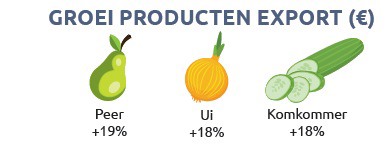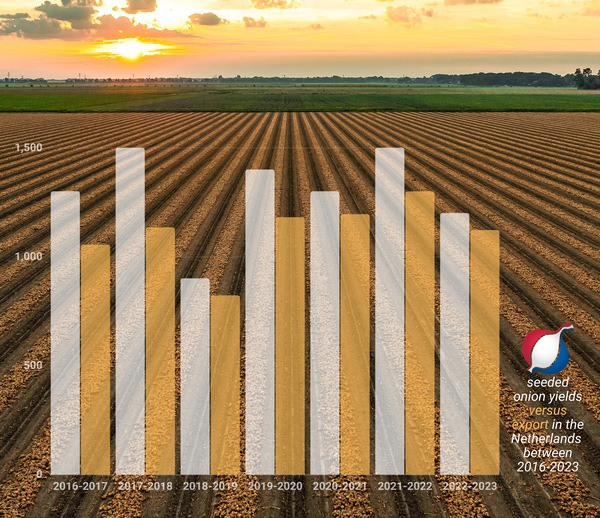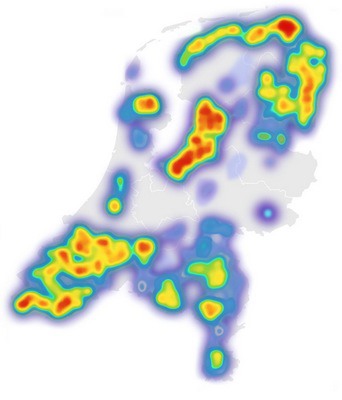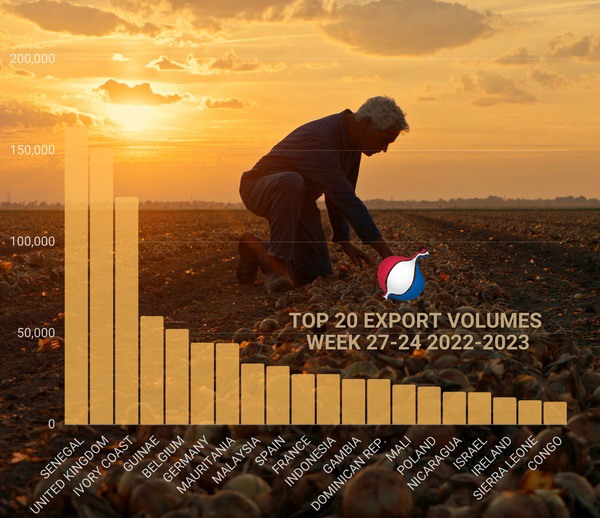With three weeks to go, the 2022-2023 Dutch onion export season is almost at an end. It will undoubtedly go down as a memorable one. It will not reach a new record, volume-wise, but regarding value, the magic half-billion euro limit will almost certainly be broken. According to recent figures, Dutch onions' export value rose by 18% in 2022, the Holland Onion Association (HOA) reports.
The export volume counter has comfortably passed the 1.1 million ton mark, a remarkable achievement considering that far fewer onions were available for export this season.

In 2022, the Dutch onion export value grew by 18%. Source: GroentenFruit Huis
Record amounts
This season, Dutch onions sold for truly record amounts. Never before this millennium have crunchy, golden-yellow onion growers in the Netherlands earned so much. That, however, has a downside. This season's high Dutch onion prices caused the ever-steady buyers like Senegal, Ivory Coast, Guinea, and Mauritania to hold back a little. However, because of insufficient local harvests, they stayed on the market.
There are also few alternatives for this sought-after vegetable eaten every day in Africa. That shortfall was, however, entirely offset by the European countries surrounding the Netherlands, who all had lower onion production this season. But for Dutch graders and exporters, high sales did not automatically mean higher profits. In the season's second half, quite a few traders had to relinquish what they had accumulated in the first half.
Lower volumes harvested
Obviously, starting at a 17% lower harvest volume, it was nearly impossible to match the previous export season. In the end, a million tons of yellow and 200,000 tons of red seed onions were harvested. That brings seed onions' total harvest volume to "only" 1.2 million tons, of which about 92% - more than 1.1 million tons - was available for export. That target will be easily met, putting this season's Dutch onion exports at roughly the same level as the 2017-2018 export season.

Onion cultivation under pressure
Climate change, and the accompanying crop failures, are causing global onion yield stagnation. That is also down to decreasing available arable land and declining soil fertility when it is insufficiently replenished with fertilizers, organic matter, and moisture. Climate change definitely affects the province where Dutch onions found their birthplace: Zeeland.
There, onion cultivation has been under increasing pressure for the past five years. That is partly due to climate change and the associated freshwater shortage, salinization, and increasing disease pressure. For example, more and more, very wet, very rainy periods alternate with very dry, warm periods. Shallow-rooting crops like onions do not like too-wet conditions. That leads to fungal diseases, bacteria, and rot during cultivation or storage.
When it is too hot and dry, the heat stresses the onions, and thrips - colloquially known as "thunder bugs" - plague them. Also, onions cannot withstand the encroaching salinization spreading in Zeeland's soil. These challenges, strongly felt in Zeeland, are sometimes already cropping up further north in the IJsselmeer polders too.
Only 10% of Zeeland's onion fields remain
Those problems mean more and more Zeeland growers chose to cultivate less risky crops like grains, reflected in the acreage figures. Zeeland's seed onion acreage has halved from 6,000+ hectares in 2017 to barely 3,000 hectares this season. That leaves Zeeland with only ten percent of the national onion area. Five years ago, it was about 30%.
Growers in Zeeland who do cultivate onions are increasingly looking for ways to irrigate with fresh water. When you use drip irrigation, you can add fertilizers and trace elements, giving additional benefits and possibly also making the crop more resistant to diseases and pests. Along with new cultivation methods, such as ridge or bed cultivation, you can get a more certain operational perspective, but costs are also considerably higher.
Uireka 3.0
Onion cultivation is a major part of crop planning in Flevoland and Zeeland and increasingly more in other Dutch provinces. The Uireka research program is a unique project involving the whole onion chain. Since 2017, it has focused on improving Dutch onions' quality and making its cultivation more sustainable and resilient. By now, the sector itself funds almost 80% of the program.
Recently, the Province of Zeeland and fairly soon after, the Province of Flevoland approved GroentenFruit Huis's grant applications for Uireka 3.0. The program researching durable onion cultivation is, thus, fully funded for 2023-2025.
of Flevoland approved GroentenFruit Huis's grant applications for Uireka 3.0. The program researching durable onion cultivation is, thus, fully funded for 2023-2025.
Right: Onion acreage concentration in the Netherlands in 2022. Source: CBS
€200,000 grant
"Research and innovation is vital to maintain Zeeland's onion sector. This €200,000 grant boosts the sector, and solutions to all challenges will be tested," says Jo-Annes de Bat, a member of the Zeeland Provincial Council.
"I particularly like the Holland Onion Association's Uireka research project's knowledge sharing. The research results will be widely disseminated among growers in Zeeland, letting growers all over the province develop."
Sustainable cultivation
"As Holland Onion Association, we're delighted with both the Provinces of Flevoland and Zeeland for warmly embracing the onion sector and wanting to contribute substantively as well as financially," Gijsbrecht Gunter, chairman of Uireka and president of the Holland Onion Association, adds.
"As chairman and co-initiator of the chain-wide onion Uireka research project, I know the funds will be effectively used in Zeeland's agricultural sector's interest. Onions and the Netherlands belong together, and cultivation is essential to the overall crop plan. Together, we're trying to find a way to make cultivation durable."
12% fewer exports in season's second half
At two-thirds of the current export season, the total export volumes until week 24 seem to be 12% lower than last season and about six percent down from the season before. Exports stand at over 1.12 million tons, with some changes in the top three from last season.
Great Britain climbs to second place
After years of dominance by Senegal and Ivory Coast as obvious numbers one and two, Great Britain has toppled Ivory Coast from its second-place position this season. Britain will easily pass the 150,000-ton mark this season. The top 20, too, differs somewhat this export season, with more European countries in it. Belgium, for instance, is in fifth place.
The Netherlands' southern neighbors will likely import about 20,000 tons more this season. That is generally true of all the Netherlands' neighbors. Poland, Germany, Spain, and Portugal are taking more, with Portugal recording the - proportionally - largest growth, from just under 1,000 tons to almost 6,000 tons. Germany is in seventh position, going from 23,000 to almost 44,000 tons.

Also unusual is Israel's (renewed) entry at number 17 with more than 17,000 tons. Brazil doubled its imports this season to 8,500 tons but remains outside the top 20. Except for Indonesia (with a growth of over nine percent) and the Dominican Republic (57% increase), all other distant destinations took considerably fewer Dutch onions. This season, these scarce onions were too expensive for those countries. Nevertheless, Dutch onions still managed to reach 130 different final destinations this export season.
Source: Holland Onion Association
